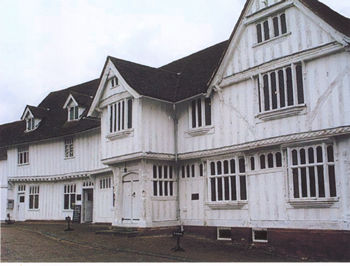BRICK
Bricks have been used in construction since ancient times both with dry fitting and mortar. Bricks may be formed by simple air drying (usually in the sun) or by being fired in a kiln. Air dried bricks (like adobe) require a high clay content to maintain their shape and strength after drying and are much more likely in regions where wood is scarce. Mortar can be made from a variety of materials, including: mud, lime, pitch, gypsum, lime, bitumen and portland cement (invented 1794). However, constructing large buildings (especially more than one story) requires a great deal of knowledge and skill.

http://en.wikipedia.org/wiki/Roman_brick
WOOD
Utilized for shelter since the beginning of time, wood is a readily available building material in some geographic settings. There are a few issues connected with its use. The first problem is, of course, fire. The closer together the buildings are, the greater an issue this is. As cities grew, many adopted ordinances restricting building materials (especially for roofs). An additional difficulty is the popularity of the material. Forests near population centers are quickly decimated. Historically, this encouraged the gentry to privatize the forests for their own uses, though generally allowing the commoners to collect dead wood "by hook or by crook." Buildings constructed entirely out of wood would therefore be much more common in smaller rural communities.

http://blog.schuttelumber.com/whats-going-on/historic-wooden-houses-in-kansas/
WATTLE & DAUB
This construction technique is a sort of blend of the above materials. Most commonly known for its use in "half-timbered" houses, a lattice is constructed of wood (wattle) and plastered (daub) to create walls within the wooden frame. As seen below, it was common to seasonally lime wash exposed beams. Because this construction technique utilizes secondary limbs, it is much less timber intensive, allowing it to be economically viable as well as regionally pervasive.

http://www.buildingconservation.com/articles/wattleanddaub/wattleanddaub.htm
STONE
Thought of as the most durable building material, stone has been widely used throughout history. Like brick, stone can be either dry-fit or mortared. However, the qualities which make stone a prized material also make it a pain in the ass. Its durability makes it much more difficult to manipulate than wood. Density, which makes it resistant to weather, makes it heavier than bricks. Quarrying stone is also an extremely laborious activity. Consequently, stone construction has long been a luxury in many areas, used for only the most important buildings.
Non-quarried stone (field stone or river stone) is much less labor intensive to acquire, but also less abundant. Fieldstone typically derives from material deposited by retreating glaciers. This is then usually collected when clearing land for cultivation (which is not an easy process). In New England, fieldstone has been used extensively to build stone walls.
Cannibalizing stone is also a long held practice. When stone buildings are abandoned or fall into disrepair they may be torn down to build something new. In England, after the fall of the Roman Empire, some of the roads and even parts of Hadrian's Wall were disassembled to reuse the materials (probably by the locals). Some homes even incorporate part of the original structure to save on labor.

http://www.visitnorthumberland.com/hadrians-wall/the-roman-wall
As a final note, defensive structures (forts, castles, walls, etc) have historically been constructed of all of these materials (excepting wattle & daub). Most early castles in Europe featured wooden palisade walls and earthen berms. The walls of Vysehrad (ca 10th C), in Prague, are made of brick. Stone examples are the most commonly depicted fortifications, but do not allow them to limit your world.
No comments:
Post a Comment